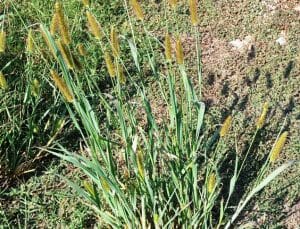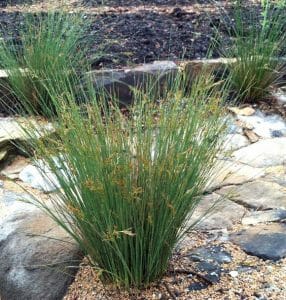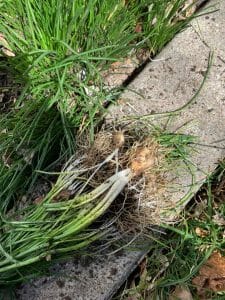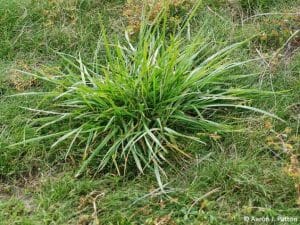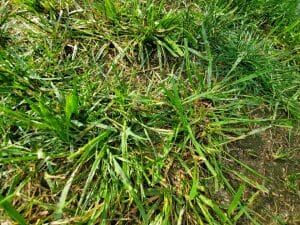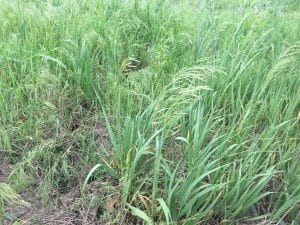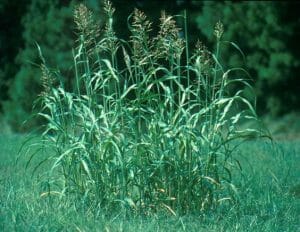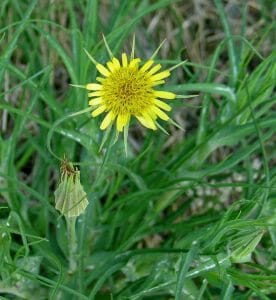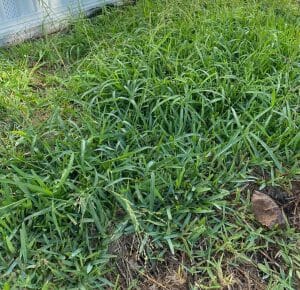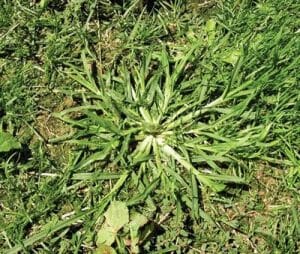Weeds with a distinct appearance from your grass are enough to cause you a migraine when they invade your lawn, but your problems double when they’re invasive weeds that look like grass. This makes it challenging to notice them, and they also make your yard unsightly.
Common Weeds that Look Like Grass in Your Lawn include:
- Crabgrass
- Goosegrass
- Nutsedge
- Creeping bentgrass
- Quackgrass
- Tall fescue
- Yellow salsify
- slender rush
- Smooth bromegras
- Green and yellow foxtail
These invasive weeds can be pretty challenging to control, and you might need to apply post-emergent and pre-emergent herbicides to eliminate them.
This post aims to help you keep your lawn weed-free by examining 15 grass-like weeds and how to control them.
Also Read: Homemade Weed Killer Recipe
Keep reading to find out more.
15 Common Weeds that Look Like Grass in Your Lawn
There are numerous types of weeds that look like grass, with some more popular than others. In this section, we will look at 15 weeds that look like grass and how to remove them.
1. Crabgrass (Digitaria sanguinalis)
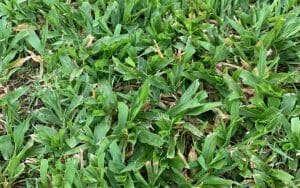
If you come across an unwanted grass type that looks like Bermuda grass in your lawn, especially if the yard is made up of a different grass type, you likely have crabgrass invasion.
This weed is also known as finger grass, and it can shoot up from any section of your lawn and spread quickly.
While it starts growing in tiny patches, it will spread out quickly in concentric circles. Crabgrass has a coarse texture and is an annual weed, so it will die off at the end of the season.
Also Read: How To Permanently Kill Weeds And Grass
Crabgrass is dangerous for your grass because it spreads swiftly, can cause permanent damage, and smothers and crowds out other plants. This weed is bright green and with a broad central fold for its leaves.
Also Read: Best crabgrass killer that won’t kill grass
How To Get Rid Of Crabgrass
Preventing the germination of crabgrass is the best way to control it, so apply pre-emergent herbicide to the yard. These herbicides are typically combined with lawn food (fertilizer).
If germination has taken place already, remove the unwanted weed by applying a direct contact herbicide or pulling it with crabgrass remover or by hand.
Read more: How do you stop weeds from growing on new sod
2. Nutsedge (Cyperus esculentus)
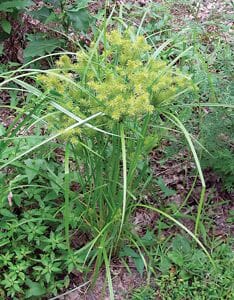
Nutsedge comes in different types, but all resemble grass and are exceptionally challenging to eliminate once they invade your lawn. They look like tall grass before blooming and maturing.
Unlike crabgrass, nutsedge is perennial, so it will thrive on your lawn for two seasons if uncontrolled.
These unwanted grass types are spread by airborne seeds and underground rhizomes and tubers, so they can easily be transferred from your neighbor’s lawn to yours and vice versa.
How To Eliminate Nutsedge
It’s worth noting that pulling out nutsedge is a bad idea because that will only encourage them to spread further.
This approach will remove the stems but leave behind tubers and roots, which will grow stronger in the next round.
The best way to control nutsedge is to choke them out by growing a thick, healthy lawn that will keep them from sprouting and spreading out.
If it has already invaded your yard, kill it using a selective herbicide applied directly at the plant base to kill the plant and its roots.
You will need to apply the herbicide at every root, which is tedious but the best approach.
Read more: Does mowing weeds kill them
3. Green and Yellow Foxtail (Setaria sp)
This is another weed that look like grass with heads resembling tiny fuzzy foxtails.
The fast-growing annual plant produces numerous seeds which easily spread far through the wind.
How To Deal With Foxtail
Control green and yellow foxtail by crowding them out and employing herbicides applied directly to the plant to protect the surrounding grass.
4. Annual Bluegrass (Poa Annua)
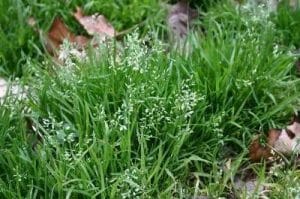
Popularly known as ‘Poa,’ annual bluegrass thrives in cool and damp areas, preferring to grow in environments with shade and sufficient water. The invasive weed usually dies when the dry, hot seasons come.
How To Deal With Annual Bluegrass
You can resort to crowding this weed by growing a thick lawn or letting your yard dry up a bit, then dig the weed out when it begins to die off then overseed the bare spots.
Alternatively, apply herbicides directly to the unwanted grass types if the above methods fail.
5. Slender Rus (Juncus tenuis)
This weed is bright green and grows like crabgrass, in clumps, spreading through seeds or by tubers. Poverty rush or path rush is difficult to eliminate through uprooting or applying herbicides because these methods can leave the weed fertile and viable to germinate.
How To Deal With Slender Rush
Although uprooting and herbicides aren’t the ideal methods of controlling slender rush, you can employ them when this weed appears, ensuring you remove the roots to curb re-emergence.
In addition, regularly mowing the lawn will prevent this grass-like weed from entering the seeding stage.
6. Wild Garlic and Onion
These weeds look like onion and garlic, smell like them, and can even be used in place of them when cooking.
They resemble tall grass, and you can detect their presence by your lawn smelling like freshly-prepared pasta sauce immediately after mowing it.
How To Control Wild Garlic And Onion
Since these plants are delicious, transfer them to your garden to continue growing and eventually use them for cooking.
Uproot them when the ground is moist, holding a big clump on your lawn to ensure you remove the plants with the roots.
You can also eliminate them through herbicide application.
7. Tall Fescue (Festuca arundinacea)
This is a highly tough weed, resistant to drought and other conditions your grass can easily succumb to.
Tall fescue spreads in the ground by rhizomes and has leaves that nearly look like succulent stems, so they quickly crowd and kill the grass when they invade your lawn.
How To Get Rid Of Tall Fescue
Don’t uproot tall fescue because you will leave behind the rhizomes. Instead, solarize it (covering the parts with the weed using an impermeable material like nylon paper for an extended period) to deprive it of water, air, and sunlight while raising the temperatures to unbearable levels, killing the weed.
You can use herbicides, but you will have to use large quantities, thus harming the lawn and the environment.
8. Quackgrass (Elymus repens)
This weed highly resembles grass and is pretty difficult to deal with since it spreads via underground rhizomes and seeds.
How To Get Rid Of Quackgrass
The best elimination method is crowding it by growing a thick lawn, but should it emerge before your yard is fully established, apply herbicides directly on quackgrass.
9. Smooth Bromegrass (Bromus inermis)
This perennial, high-adaptable weed is pretty tough to get rid of because it’s hard and will effortlessly take over a thin lawn.
Nonetheless, the rhizome-promulgating weed offers great ground cover because of its tight root system and robust growth and makes excellent hay.
How to Eliminate Smooth Bromegrass
Control this weed by crowding it with a thick lawn, but if that fails, apply herbicides to it directly.
10. Alexandergrass (Brachiaria plantaginea)
It’s a perennial weed called creeping signalgrass or tropical signalgrass, and it resembles St. Augustine. It can easily choke out your lawn if uncontrolled due to its robust growth.
How To Get Rid Of Alexandergrass
Since there are no herbicides capable of killing alexandergrass, get rid of it by burning it with baking soda, dig it up, then replant the area with good grass.
11. Yellow Salsify (Tragopogon dubius)
This grass-like weed thrives in sunny areas, producing yellow flowers in summer and large puffballs as fall dawns. The perennial or biennial plant can grow up to 3 ft tall and 2 ft wide.
How to get rid of yellow salsify
Prevent this weed from taking root through mulch beds. You can also uproot it by hand.
12. Johnson Grass (Sorghum halepense)
It’s a noxious and invasive weed that spreads via rhizomes and seeds and can easily plague your lawn.
How To Eliminate Johnsongrass
Get rid of johnsongrass from your lawn by applying herbicides.
13. Creeping Bentgrass (Agrostis stolonifera)
The weed is blueish-green and prevalent in golf courses but can also grow on your lawn. Creeping bentgrass makes your yard unsightly, infects the lawn with dollar spot look, and makes it patchy.
How to get rid of creeping bentgrass
Eliminate this unwanted grass type from your lawn using herbicides. The commonly used treatment is Tenacity.
14. Carpetgrass (Axonopus fissifolius)
 It’s a warm-season perennial weed with yellowish-green or pale green leaves and has similar characteristics to centipede grass.
It’s a warm-season perennial weed with yellowish-green or pale green leaves and has similar characteristics to centipede grass.
How to Eliminate Carpetgrass
Growing a thick, healthy lawn prevents carpetgrass invasion, while herbicides will kill them.
15. Goosegrass (Eleusine indica)
This weed grows in lawns in early summer and late spring, and it’s usually confused with crabgrass, but it’s finger-shaped and has a head.
How to Eliminate Goosegrass
You can pull this weed with a tiny trowel or by hand. Another solution is using a pre-emergent herbicide.
How to tell the difference between grass and weeds
It’s easy to differentiate broadleaf weeds (they are big and sometimes resemble flowers) from the grass because they don’t look alike.
However, the same can’t be said about grassy weeds, but you can still detect their presence on your lawn.
Weeds can make your lawn appear disheveled and patchy, and they can grow thorns. Moreover, if the plant sprouting out of your yard in patches doesn’t look like the grass you planted, they are likely weeds.
Final Remarks
Different types of weeds that look like grass can easily invade your lawn, and detecting their presence can be challenging. However, it’s not impossible so monitor your yard correctly, pay attention to unwanted plants, and adopt effective weed control strategies.
Here is a list of 15 Common Weeds that Look Like Grass in Your Lawn:
- Crabgrass
- Goosegrass
- Quackgrass
- Annual bluegrass
- Foxtail
- Dallisgrass
- Bermudagrass
- Nutsedge
- Ryegrass (annual)
- Witchgrass
- Slender Rush
- Wild Garlic and Onion
- Tall Fescue
- Smooth Bromegrass
- Alexander grass
- Yellow Salsify
- Johnson grass.
Sources and References
- UMass Extension Turf Program – Biology and Management of Crabgrass
- Clemson Extension Home & Garden Information Center – Nutsedge
- University of Missouri’s Integrated Pest Management – Foxtails

Hey there, I’m Derek Schew, a writer for Lawnholic.com, where we cover everything and anything related to lawns. As someone who’s spent countless hours tending to my own lawn, I’m passionate about sharing my knowledge and helping others achieve the perfect yard. From lawn care tips to product reviews, I’m committed to providing our readers with the most accurate and up-to-date information available. So whether you’re a seasoned lawn enthusiast or just getting started, I invite you to join our community and discover the joys of a lush, green lawn.

